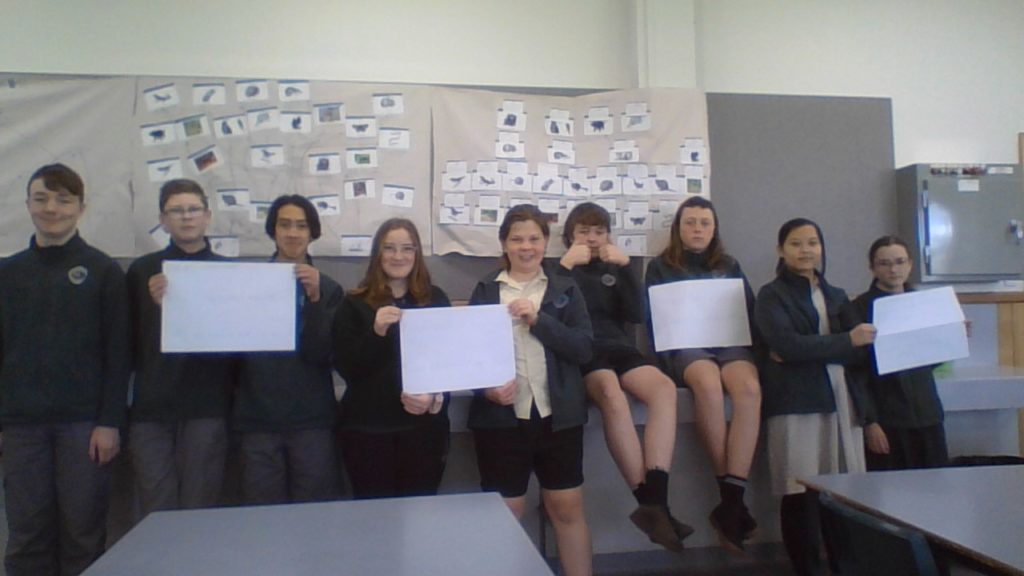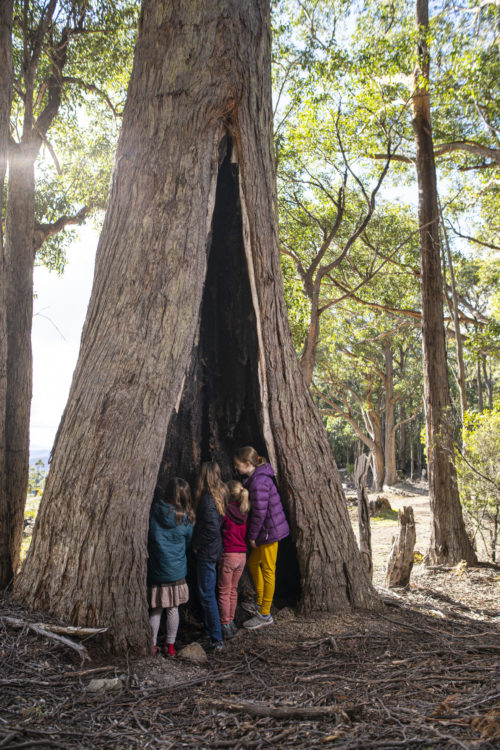Devonport High School Grade 8B

Our Questions
I have been asked a lot about how climate change works – what is it, how does it happen, and what happens to the Earth with global warming. To answer this I’ll start by talking about the difference between weather and climate. As I’m sure you know, weather is the changes in temperature, rainfall and wind that we see outside from day to day, while climate refers the usual weather of a place. Tasmania has a cool temperate climate overall, but the west coast has a wetter climate than the east coast, and the central regions have a cooler climate than the coast. The Earth also has a climate; Earth’s climate is what you get when you combine all the climates from around the world together.
Climate change is a change in the usual weather of a place. While the weather can change in just a few hours (as it often does in Tassie!), climate change occurs over many years. And in fact the Earth’s climate has always been changing. As I’m sure you know, there have been times in the past when the Earth was much hotter than it is today, and also times when it has been much cooler. But an important difference with climate change caused by human activities is that the change is occurring much, much faster than we have ever seen before.
There are lots of different things that can cause climate to change – volcanic eruptions, changes in the world’s oceans, and changes in the activity of our sun. Climate change caused by humans is due to the gases we release into the atmosphere – particularly carbon dioxide from burning fossil fuels, but also methane and other gases. These gases cause a green-house effect which traps more of the sun’s energy in Earth’s atmosphere and so warms the planet. This warming also causes changes in other features of our climate such as rainfall.
Earth's temperature will keep going up for at least the next 100 years. This will cause more snow and ice to melt and sea levels to rise. Some places will get more rain and others will get less rain. There will be more heatwaves and some places might have stronger storms. The sooner we can stop emitting greenhouse gases and implement solutions to take excess carbon dioxide out of the atmosphere, the better chance we have of minimising the impacts of climate change on our Earth.
What and interesting question! We asked three scientists what they'd be doing if climate change didn't exist.
Thanks for asking about Tasmania’s contribution to climate change!
To assess states’ or countries’ contribution to the gases that create climate change, climate scientists try to measure how much greenhouse gas is release into the atmosphere because of human activities. Trapped greenhouse gases cause warming of the atmosphere and the surface of the Earth.
Most carbon emissions come from burning fossil fuels or wood for transport, heating our homes, and industrial processes. Methane is emitted by agriculture and waste. The other category is land-related emissions. Land-related emissions simply mean the stored carbon lost through forestry activities such as logging and land clearing for agriculture.
Tasmania is unusual in Australia because we generate 100% renewable electricity from hydropower and wind turbines. If we look at Tasmania’s emissions, agriculture made the biggest contribution of 2.4 megatonnes of greenhouse gases in 2019 (that’s the weight of 400,000 elephants), followed by transport, at 1.8 megatonnes, and burning fuels for industrial operations, together with household heating and cooking, at 1.75 megatonnes..
The good news is that despite all the emissions that have been released by human activities, Tasmanian forests neutralize all these emissions! Trees breathe in carbon dioxide and turn it into carbon and oxygen. The latest data (2019) tells us Tasmania is currently removing more carbon dioxide from the atmosphere than it is producing.

But that’s not the whole story – the reporting doesn’t count the emissions from forest that burns in bushfires. As the climate heats up, bushfires are more likely to happen, so we need to make sure we use healthy fire and forestry techniques to prevent out-of-control fires that could be a major cause of greenhouse gas emissions. Let’s give a big shout out to Tasmanian forests and make sure we protect them!!
I have been asked a lot about how climate change works – what is it, how does it happen, and what happens to the Earth with global warming. To answer this I’ll start by talking about the difference between weather and climate. As I’m sure you know, weather is the changes in temperature, rainfall and wind that we see outside from day to day, while climate refers the usual weather of a place. Tasmania has a cool temperate climate overall, but the west coast has a wetter climate than the east coast, and the central regions have a cooler climate than the coast. The Earth also has a climate; Earth’s climate is what you get when you combine all the climates from around the world together.
Climate change is a change in the usual weather of a place. While the weather can change in just a few hours (as it often does in Tassie!), climate change occurs over many years. And in fact the Earth’s climate has always been changing. As I’m sure you know, there have been times in the past when the Earth was much hotter than it is today, and also times when it has been much cooler. But an important difference with climate change caused by human activities is that the change is occurring much, much faster than we have ever seen before.
There are lots of different things that can cause climate to change – volcanic eruptions, changes in the world’s oceans, and changes in the activity of our sun. Climate change caused by humans is due to the gases we release into the atmosphere – particularly carbon dioxide from burning fossil fuels, but also methane and other gases. These gases cause a green-house effect which traps more of the sun’s energy in Earth’s atmosphere and so warms the planet. This warming also causes changes in other features of our climate such as rainfall.
Earth's temperature will keep going up for at least the next 100 years. This will cause more snow and ice to melt and sea levels to rise. Some places will get more rain and others will get less rain. There will be more heatwaves and some places might have stronger storms. The sooner we can stop emitting greenhouse gases and implement solutions to take excess carbon dioxide out of the atmosphere, the better chance we have of minimising the impacts of climate change on our Earth.













